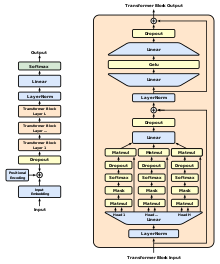
A chatbot is a software application or web interface that is designed to mimic human conversation through text or voice interactions. Modern chatbots are typically online and use generative artificial intelligence systems that are capable of maintaining a conversation with a user in natural language and simulating the way a human would behave as a conversational partner. Such chatbots often use deep learning and natural language processing, but simpler chatbots have existed for decades.
Multimodal learning, in the context of machine learning, is a type of deep learning using a combination of various modalities of data, such as text, audio, or images, in order to create a more robust model of the real-world phenomena in question. In contrast, singular modal learning would analyze text or imaging data independently. Multimodal machine learning combines these fundamentally different statistical analyses using specialized modeling strategies and algorithms, resulting in a model that comes closer to representing the real world.

OpenAI is an American artificial intelligence (AI) research organization founded in December 2015, researching artificial intelligence with the goal of developing "safe and beneficial" artificial general intelligence, which it defines as "highly autonomous systems that outperform humans at most economically valuable work". As one of the leading organizations of the AI boom, it has developed several large language models, advanced image generation models, and previously, released open-source models. Its release of ChatGPT has been credited with starting the AI boom.
Generative Pre-trained Transformer 3 (GPT-3) is a large language model released by OpenAI in 2020. Like its predecessor, GPT-2, it is a decoder-only transformer model of deep neural network, which supersedes recurrence and convolution-based architectures with a technique known as "attention". This attention mechanism allows the model to selectively focus on segments of input text it predicts to be most relevant. It uses a 2048-tokens-long context, float16 (16-bit) precision, and a hitherto-unprecedented 175 billion parameters, requiring 350GB of storage space as each parameter takes 2 bytes of space, and has demonstrated strong "zero-shot" and "few-shot" learning abilities on many tasks.

Generative Pre-trained Transformer 2 (GPT-2) is a large language model by OpenAI and the second in their foundational series of GPT models. GPT-2 was pre-trained on a dataset of 8 million web pages. It was partially released in February 2019, followed by full release of the 1.5-billion-parameter model on November 5, 2019.

DALL·E, DALL·E 2, and DALL·E 3 are text-to-image models developed by OpenAI using deep learning methodologies to generate digital images from natural language descriptions, called "prompts."

Generative Pre-trained Transformer 1 (GPT-1) was the first of OpenAI's large language models following Google's invention of the transformer architecture in 2017. In June 2018, OpenAI released a paper entitled "Improving Language Understanding by Generative Pre-Training", in which they introduced that initial model along with the general concept of a generative pre-trained transformer.
Prompt engineering is the process of structuring an instruction that can be interpreted and understood by a generative AI model. A prompt is natural language text describing the task that an AI should perform.
A foundation model is a machine learning or deep learning model that is trained on broad data such that it can be applied across a wide range of use cases. Foundation models have transformed artificial intelligence (AI), powering prominent generative AI applications like ChatGPT. The Stanford Institute for Human-Centered Artificial Intelligence's (HAI) Center for Research on Foundation Models (CRFM) created and popularized the term.

ChatGPT is a chatbot developed by OpenAI and launched on November 30, 2022. Based on large language models (LLMs), it enables users to refine and steer a conversation towards a desired length, format, style, level of detail, and language. Successive user prompts and replies are considered at each conversation stage as context.

In the field of artificial intelligence (AI), a hallucination or artificial hallucination is a response generated by AI which contains false or misleading information presented as fact. This term draws a loose analogy with human psychology, where hallucination typically involves false percepts. However, there’s a key difference: AI hallucination is associated with unjustified responses or beliefs rather than perceptual experiences.
Generative Pre-trained Transformer 4 (GPT-4) is a multimodal large language model created by OpenAI, and the fourth in its series of GPT foundation models. It was launched on March 14, 2023, and made publicly available via the paid chatbot product ChatGPT Plus, via OpenAI's API, and via the free chatbot Microsoft Copilot. As a transformer-based model, GPT-4 uses a paradigm where pre-training using both public data and "data licensed from third-party providers" is used to predict the next token. After this step, the model was then fine-tuned with reinforcement learning feedback from humans and AI for human alignment and policy compliance.

GPT-J or GPT-J-6B is an open-source large language model (LLM) developed by EleutherAI in 2021. As the name suggests, it is a generative pre-trained transformer model designed to produce human-like text that continues from a prompt. The optional "6B" in the name refers to the fact that it has 6 billion parameters.
A large language model (LLM) is a computational model notable for its ability to achieve general-purpose language generation and other natural language processing tasks such as classification. Based on language models, LLMs acquire these abilities by learning statistical relationships from text documents during a computationally intensive self-supervised and semi-supervised training process. LLMs can be used for text generation, a form of generative AI, by taking an input text and repeatedly predicting the next token or word.
In deep learning, fine-tuning is an approach to transfer learning in which the parameters of a pre-trained model are trained on new data. Fine-tuning can be done on the entire neural network, or on only a subset of its layers, in which case the layers that are not being fine-tuned are "frozen". A model may also be augmented with "adapters" that consist of far fewer parameters than the original model, and fine-tuned in a parameter–efficient way by tuning the weights of the adapters and leaving the rest of the model's weights frozen.

Generative artificial intelligence is artificial intelligence capable of generating text, images, videos, or other data using generative models, often in response to prompts. Generative AI models learn the patterns and structure of their input training data and then generate new data that has similar characteristics.
Llama is a family of autoregressive large language models (LLMs), released by Meta AI starting in February 2023.

PaLM is a 540 billion parameter transformer-based large language model developed by Google AI. Researchers also trained smaller versions of PaLM, 8 and 62 billion parameter models, to test the effects of model scale.
Whisper is a machine learning model for speech recognition and transcription, created by OpenAI and first released as open-source software in September 2022.
Claude is a family of large language models developed by Anthropic. The first model was released in March 2023. Claude 3, released in March 2024, can also analyze images.










